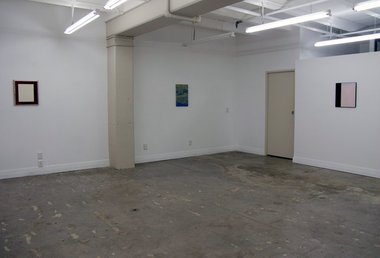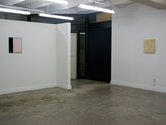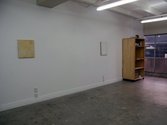John Hurrell – 2 July, 2011
This strange quintet of competing, discordant, woven together processes - looking through / at / through / at / through the wall - had support properties (their hard / soft surfaces) not accentuated by the brush-applied or squeegee-removed paint, but contradicted.
The five modestly sized, emotionally cool paintings presented by Johl Dwyer in RM alternated between canvas stretcher supports and wooden panels in their positioning. There was no list of works provided and no titles - pure visual experience in the sense of no stated verbal framing (apart from the enigmatic exhibition title). Also these works were less frenetic and less sculpturally tactile than I expected, considering the little I’ve seen from this artist so far in other shows.
The three wooden panels as a (spread apart) set teased out notions of solidity and transparency by employing concentric square painted ‘frames’ that were symmetrically positioned in two, asymmetrically in another, sometimes on the support surface, or inside or behind that support - and which when covered with gesso, seemed translucent or very thin. Within the three, sweet lyrical thin colour contrasted with raw, stridently abrasive thicker paint, or no obvious colour at all (only white gesso), apart from damp oily looking borders.
Dwyer’s two wrap-around canvases on stretchers appeared to be monoprints or subtracted top layers in the squiggly scraped manner of Judy Millar. One was sufficiently faint and delicate that it seemed to have been stained with washes and perhaps scrubbed. The other had assertively shrill, acidic colours vibrating with dramatic vertical sweeps.
This strange quintet of competing, discordant, woven together processes - looking through / at / through / at / through the wall - had support properties (their hard / soft surfaces) not accentuated by the brush-applied or squeegee-removed paint, but contradicted. Tunnelling through and blocking off pictorial space side by side, they celebrated the making of painting by coaxing and thwarting the viewer’s penetrative gaze simultaneously.
John Hurrell










 Two Rooms presents a program of residencies and projects
Two Rooms presents a program of residencies and projects Advertising in this column
Advertising in this column



This Discussion has 0 comments.
Comment
Participate
Register to Participate.
Sign in
Sign in to an existing account.